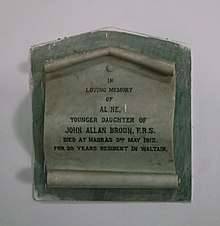John Allan Broun
John Allan Broun FRS (21 September 1817 – 22 November 1879) was a Scottish scientist with interests in magnetism, particularly of the earth, and meteorology. Broun studied in Edinburgh University and worked at the observatory in Makerstoun from 1842 to 1849 before moving to India to work in the Kingdom of Travancore. He continued his studies on geo-magnetism in India and was involved in setting up observatories there apart from managing the Napier Museum in Trivandrum. One of the fundamental discoveries he made was that the Earth loses or gains magnetic intensity not locally, but as a whole. He also found that solar activity causes magnetic disturbances.
John Allan Broun | |
|---|---|
| Born | 21 September 1817 |
| Died | 22 November 1879 (aged 62) |
| Nationality | Scottish |
| Known for | meteorologist |
| Awards | FRS Royal Medal (1878) Keith Medal (1859-61) |
Early years
Broun was born in Dumfries and educated at Edinburgh University and was later the director of the magnetic observatory at Makerstoun, in Scotland, from 1842 to 1849. This observatory had been founded by Sir Thomas Brisbane. The observations Broun made at Makerstoun were published in the Transactions of the Royal Society of Edinburgh.
Work in India

From 1852, Broun was director of Trivandrum Observatory, in Trivandrum, in Travancore, India. Trivandrum is today known as Thiruvananthapuram, and is the capital of the Indian State of Kerala, but then it was the capital of the princely state of Travancore, a territory in a subsidiary alliance with British India. The observatory had been founded in 1841 by Swathi Thirunal Rama Varma, the Maharajah of Tranvacore. The first director of the observatory was John Caldecott (1800-1849). The observatory is now part of the University of Kerala, and is one of the oldest of its kind in India. The rulers of Tranvacore during the time of Broun were Uthradom Thirunal (until 1860) and his successor Ayilyam Thirunal.
Broun, while still in India, was elected a Fellow of the Royal Society of London in 1853. He also built an observatory on Agastya Mala, the highest peak in Travancore, and helped to found the museum and zoological gardens in Trivandrum. This museum was later demolished and replaced by what is now called Napier Museum. The original zoological gardens still survive as Trivandrum Zoo.
Later career
Braun left India in 1865, living in Lausanne, Switzerland, and then Stuttgart, Germany, before arriving in London, England, in 1873. He then, with a grant from the Royal Society, worked on analysing magnetic observations made at colonial stations.[1] He also published reports on the Makerstoun and Trivandrum observatories. In 1878, he was awarded the Royal Society's Royal Medal for over 35 years of work on magnetism and meteorology.
References
- Broun, John Allan (1 January 1861). "XXIII.—On the Horizontal Force of the Earth's Magnetism". Earth and Environmental Science Transactions of the Royal Society of Edinburgh. 22 (3): 511–565. doi:10.1017/S0080456800031409. ISSN 2053-5945.
Sources
- Entry for John Allan Broun in Dictionary of National Biography (1903)
- A. M. Clerke, Anita McConnell, Broun, John Allan (1817–1879), rev. Anita McConnell, Oxford Dictionary of National Biography, Oxford University Press, 2004
- Entry for Broun in the Royal Society's Library and Archive catalogue's details of Fellows (accessed 22 April 2008)
- History of the University, including the University Observatory, from the University of Kerala
External links
- Manuscripts of John Allan Broun, from the National Library of Scotland
- John Allan Broun entry at the UK's National Archives
- History of Trivandrum Museum, with three reports by Broun on the museum, the zoological park and the gardens at Trivandrum
- "Proposed Institution of Actinometric Observations in India". New Delhi: National Archives of India. 1879. PR_000003043762.